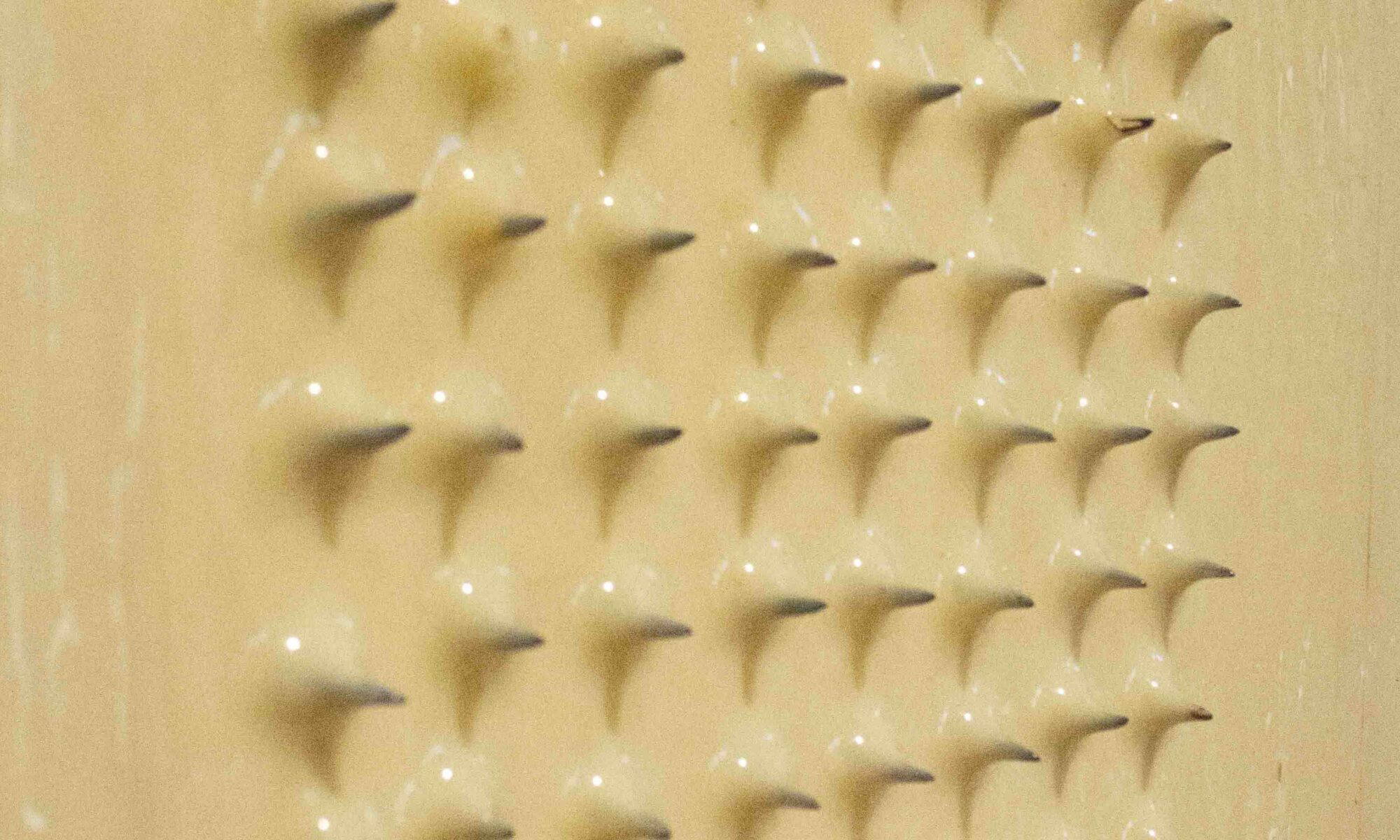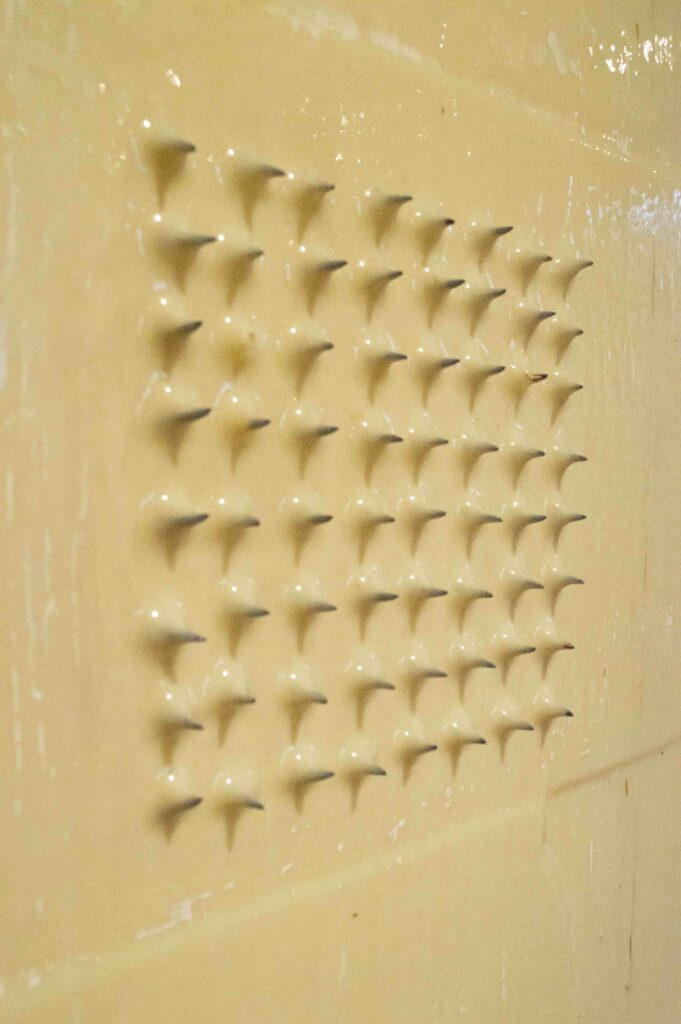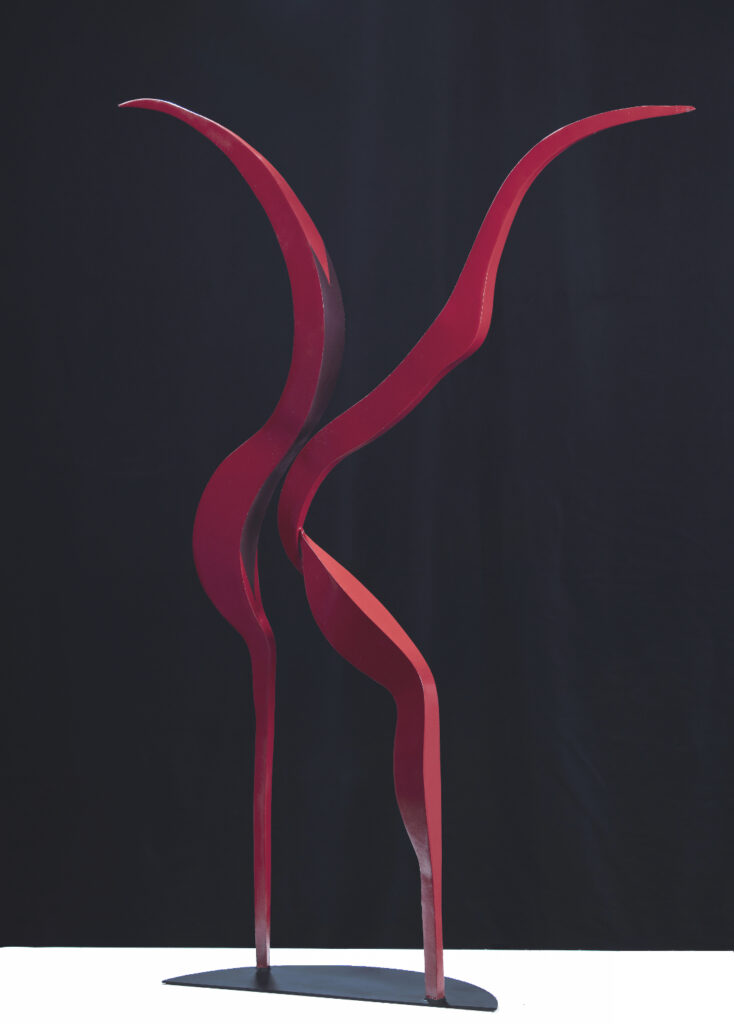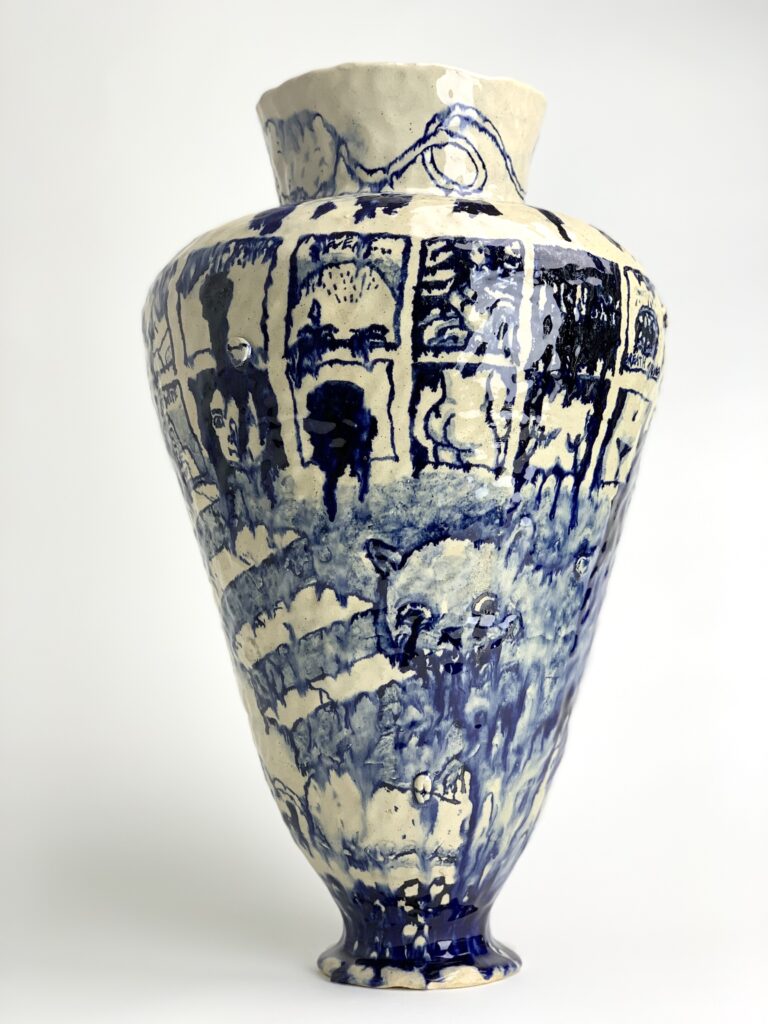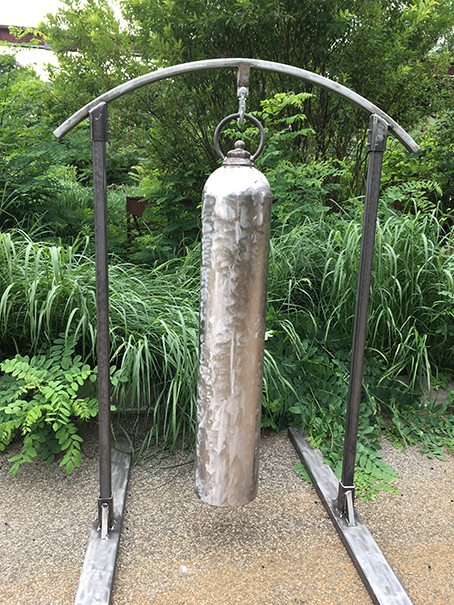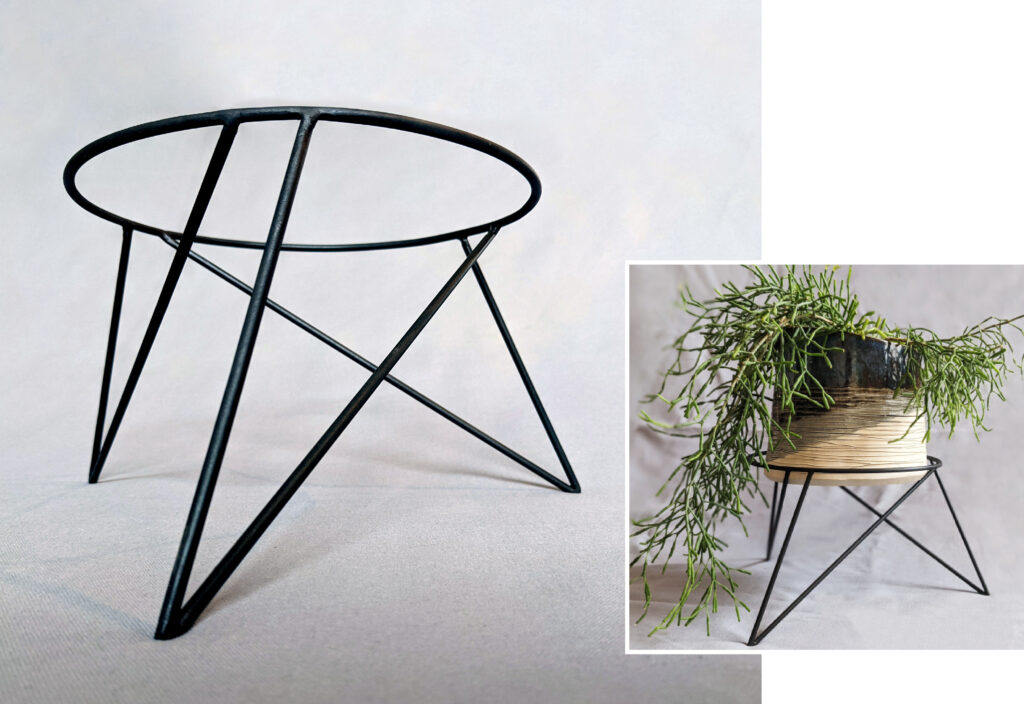2021 Resident Artist Exhibition
The Wurks Gallery, August 13-21
The Steel Yard is opening its inaugural artist residency show on Friday, August 13 at The Wurks Gallery on Acorn Street in Providence. The curated exhibit will include twelve artist residents; all of whom will share their unique perspective of industrial art.
The Exhibit will be open to the public Friday, August 13, 6 PM – 9 PM and closes on Saturday, August 21, 6 PM – 9 PM. Open gallery hours on Wednesday, August 18, Thursday, August 19, Friday, August 20, 3 PM – 6 PM
FEATURED ARTISTS
Justin Dillenbeck
Elsa Hoffman
Tom Hubbard
David Karoff
Maxime Lefebvre
Joss Liao
Victoria Milne
Henry Robinson
Ellen Rogers
Rena Rong
Emily Rye
Justin Dillenbeck (he/him)
I believe that good pottery serves to enhance a person’s daily experience of eating and drinking while simultaneously stimulating mindfulness and togetherness. A good pot makes for an interesting visual and tactile experience while fulfilling its primary role as a vehicle for sustenance and connection. Each piece is thrown with an undulating rim or altered in some way to celebrate the fluidity of clay while terra sigillata and/or clay slips are used to celebrate the texture and depth of clay in its very first stages of formation. The joys I derive from clay are a result of connecting with a community and from the very act of making and working with my hands. These pots serve as a manifestation of living into these joys.
Justin Dillenback is a full-time studio potter. After earning his B.A. with a concentration in ceramic arts in 2016 at Wheaton College in Illinois, Justin spent several summers teaching and managing a ceramics studio in Northern Wisconsin. Justin additionally spent several years working to empower at-risk youth in their journeys of healing. Realizing the importance of the physical manifestations of growth in a person’s journey of healing, Justin made the move to Vermont to make pots full-time with Farmhouse Pottery. Justin has led a terra-sigillata workshop at his community’s art center and now hopes to continue exploring in clay while looking for opportunities to invite others into that empowering process of making.
Elsa Hoffman
Using a handheld plasma cutter as a drawing tool, I create graceful, energetic, loose imagery depicting figurative movement, bountiful flora and snapshots of everyday scenes. Often displayed as installations in darkened spaces brought to life by illumination, my work plays with light, shadow, and imagery inspired by the vibrancy and strength of the natural world. The cutting process, which allows no room for erasure, captures the gestural quality of drawing, the laciness of paper cutouts, and the strength of industrial material. Unlike the heavily mechanized and strictly controlled cutting processes typically utilized in metal shops, the plasma cutter allows my hand to react to the imagery during the cutting process. The imperfections and irregularities that are inevitable to the process bring the imagery to life.
Growing up in the countryside with a family that highly valued craft and art integrated into the home space, I feel a deep connection to my natural environment and the functional objects around me. As I have developed my technical plasma cutting skills, I have explored different opportunities to incorporate my cut metal panels into a variety of design applications for home and public environments. Whether it is metal sconces with designs of plants from the client’s garden, a metal table made for a beach house using ocean water as a patina, or workpants decorated with imagery of flora along the Providence Bay, I am forever inspired by and connected to how an object can interact with and be responsive to its surrounding environment.
Elsa Hoffman was born and raised in the Piedmont of North Carolina. She now lives in Providence, RI and works at the Steel Yard as an Alloy Fellow: artist-in-residence where she makes functional and artistic metalwork. After graduating from Oberlin College in 2010 with a BA in studio art and environmental studies, she worked as an assistant for the site-specific sculptor, Patrick Dougherty. Simultaneously, Hoffman designed and built her own functional wood cabinetry and furniture as a member of a community woodworking cooperative. She first began to work with metal in 2012 when she was introduced to the plasma cutter, handheld cutting torch, as a drawing tool. Hoffman immediately fell in love with the process, as it allowed her to translate her intricate drawings into illuminated metal cutouts.
Hoffman has since been honing her welding and cutting skills and has become particularly renowned for her loose and gestural metal cutouts. Her large-scale work has been exhibited in galleries, botanical gardens, homes, and businesses throughout NC as well as in the Julian Robertson Collection in NYC, Union Station, Raleigh, NC, and at the UNC Project Annex in Lilongwe, Malawi.
Tom Hubbard (he/him)
My approach to art-making is rooted in my design training and the belief that the best solution often comes from the problem itself. Allowing each project to evolve naturally through a process of inquiry, research, and immersion, I explore, interpret and distill visual opportunities into solutions that are specific, unique, and meaningful. Tempered by a minimalist approach – loss, memory and the passage of time are threads often running through my work. My recent work is informed by current events, the effects of mobility, and my response to place. Growing up in the Midwest, I found abandoned buildings, bridge trusses, and industrial fittings endless sources of inspiration. Informed by a studio set in a century-old steel yard and inspired by blacksmith’s swage blocks, industrial castings and USGS survey markers, my recent ceramic work celebrates the beauty and ambiguity of simple industrial forms. These ceramic sculptures reinterpret industrial forms as elegant, refined, and ambiguous objects allowing the viewer to freely interpret the forms, their markings, and their meanings.
Tom Hubbard is an interdisciplinary artist whose approach is rooted in his design training. His practice includes ceramics, mixed media and public art installations. History, memory and the effects of mobility are threads often running through Hubbard’s work. Recent commissions include the Indianapolis Museum of Contemporary Art, The Greater Cleveland RTA and the City of Columbus, OH. His work has been exhibited widely and is included in several private and corporate collections including the Fort Wayne Museum of Art and the Community Foundation of the CSRA. Hubbard was born in San Francisco, CA and received a BFA from Indiana University. He grew up in the midwest and has called Maine, Ohio, The Netherlands and Georgia home. Hubbard currently lives and works outside Providence, RI.
David Karoff (he/him)
Perhaps I should be embarrassed to admit to never hearing of the term creative practice until becoming an artist mentor at New Urban Arts in 2007. But, once I did, it made so much sense: that everyone can benefit from a creative thread running through their entire lives, perhaps taking different forms at different times, but always there, infecting – in the best way – all it touches. I believe in that. Important to me in my creative practice:
- the sometimes-tense intersection between the natural and made environment. There’s often great beauty and meaning there.
- provoking surprise in concept and form.
- juxtaposing different materials (e.g. stone and steel) in unlikely ways.
- continuously developing my technical skills and learn new processes and tools. It means something to me to hear the staccato purr of a good weld. (That’s not what I always hear, but it now happens much more often.)
- moving efficiently from concept to final product, without missing essential opportunities for serendipity.
- creating pieces that can be seen by a wider public. I want some of them to be big.
- On the aesthetics vs. concept question, I’m in the middle. I would never be satisfied with a piece that satisfied only one pole of that spectrum. I want to say something – make people think – with more than apparent craftsmanship, and I want to examine important ideas without being an ideologue.
David Karoff has lived in Providence working in RI’s nonprofit sector for over 35 years. Much of that time he set aside art-making, which had been a significant part of his life in high school and college. Over a decade ago, he found the Steel Yard and began making sculpture again, eking out very limited hours from work and family for art. Some were ideas set aside to percolate (molder?) on scraps of paper decades ago.
As for so many people, this past year has been a period of radical transition. Outside of the pandemic, he largely transitioned from his nonprofit career and has dedicated much of his time to making art.
The four months as a Micro-Resident have been a time of great creative unrest. One of his goals for the residency was to make bigger pieces. In just over three months he’s created four pieces (three big and one small), each very different in concept and execution. Two have been submitted to juried shows (pending notification) and one was made on commission. He’s built on pre-existing skills and techniques and acquired some new ones, and learned how to work with pieces – cumulatively weighing over 500 pounds — that he can no longer lift alone.
He’s now poised to make a significant life change. His children are independent adults, and he’s ready to focus on making art. His parents are ninety-one. He expects to have at least a quarter-century for this next phase of his life.
Maxime Lefebvre (he/him)
Ever since I came to the United States, I developed a fascination for the constant extreme contrasts that I feel surrounded by. This appeal Grst expressed through tiles installations and wallpapers, and ceramics came quite naturally, as the urge of making things in a three-dimensional way was becoming more and more pressing.
I enjoy subverting common materials and images from popular culture, ranging from cinder blocks to Jackie Kennedy in the White House. The cinder blocks that I made were an attempt to remove them as much as possible from any industrial process. They are hollow, fragile, and cannot bear any weight, which contradicts their original purpose. My thesis, Views, was focusing on the wallpaper Views of North America on display in the Diplomatic Reception Room in the White House. That wallpaper was handmade in France and is a very idealistic and utopic depiction of America, and reminded me of my own vision before I came to this country.
My latest project stems from my observations in American supermarkets, that felt like museums. I decided to focus on detergent bottles, primarily because of their simplistic yet beautiful shapes, and the plurality of their designs, specific to every brand. I recreated each bottle in ceramics and I have been applying different grids to them so that the viewer’s attention would be focused on the shape and not solely on the brand, while still feeling familiar and uncanny.
Maxime Jean Lefebvre was born and raised in France. He started experimenting with ceramics early on and was brought to a lot of history museums as a youngster. After graduating from the École Nationale Supérieure d’Art de Bourges, he moved to America to pursue his MFA in Printmaking at RISD. Maxime is inspired by history and systems of power, and by his experience as a foreigner in America. Through his current body of ceramic work, he is exploring relationships between commerce, systemization, and the everyday familiar.
Joss Liao (she/her)
As an interdisciplinary artist, I’m focused on combining glass with jewelry making process. Taking advantage of the compatibility between glass and copper, I experiment with bringing the translucency and transparency of glass to the traditional jewelry framework. I’m always excited with the phenomenons that unfold during material experimentation and believe that there are endless possibilities in this collaborative space. Jewelry making means creating objects of a hand-held scale to me, and I’m extremely interested in inventing monumentality in liminal spaces. I enjoy the wearable aspect of jewelry works and I’ve been invested in making wearables that make a conceptual statement. Such a statement will reveal as the user interacts with the object over time, like a secret to be slowly discovered over time.
Currently, I’m researching traditional techniques that involve combining metal with glass, such as enameling, mounting and the stained glass process. With my expertise in glass, I hope to bring new life to these techniques and grow my own practice with my own aesthetic and things to say.
Grew up in Singapore, Shanghai, and the US, Joss has been exposed to multiple cultures and drastically different people from an early age. Due to this experience of combining multiple cultural roots in her body, Joss is naturally driven to experiment with the co-existing possibilities of processes and materials from different disciplines. Recently graduated from Rhode Island School of Design, she experimented wildly across disciplines during her time in school. Rooted in the glass department and her own studio practice, she extended her interests to curatorial work, art criticism, sound art, etc. as well as multiple liberal arts disciplines, such as gender and sexualities studies, English, and anthropology. During her final year, Joss took a class in the jewelry department and discovered her passion for metalworking. As a sexual assault survivor and a woman of color, Joss feels passionate to make social commentary artworks and statement pieces that raise awareness. Through her artworks that bring not only aesthetic pleasure but conceptual weight, she hopes to investigate difficult topics such as sexism and ableism in an accessible way. She believes in the art’s power to express and communicate and hopes to move, inspire and connect more people through her artworks. As of now, Joss is based in Providence and transitioning from a college student to a young artist. In this stage, she intends to keep experimenting and pushing her practice while finding different ways to sustain her career financially.
Victoria Milne (she/her)
Sculpture is, for me, poetry made visible. The form allows me to express something complex and deeply personal succinctly. Using elemental forces and materials grounds me and brings my visions, emotions and life events fully into the world where I hope the work will resonate or provoke thoughts or feelings for those who view it.
My approach varies from playful, in-the-moment creations to more structured work for which I have a specific outcome in mind. I may use an intriguing found object as a starting point, focus on something I see inherent in the object; a shape or image out of context – a broken shell, a line or pattern of rust – and expand on that. Alternatively, when I’m working on larger more deliberate pieces, I sketch or use 3d modeling to map out my ideas before starting the work.
Using my hands and body to manifest tangibly what is in my head and heart is both freeing and challenging. It’s often a surprise to see the final result of the transformation from what I intended to what the piece dragged me into; what the various technical difficulties or limits caused me to change or edit out; or the opposite when I expected less and got more because something struck me in the middle of the process and whispered: “Do it like this instead”.
Florida-based sculptor Victoria Milne a.k.a. Enigmachick uses sculpting to explore ideas, emotions, perceptions, and observations using a variety of materials and formats. Her work and inspiration vary, some pieces taking years to design and others taking place in the moment when she lets the shapes and textures of objects lead her. She works mostly in metal, often incorporating found objects, (stone, glass, wood, or whatever catches her eye), either as the point of departure or as an accent.
Since studying metal sculpting at the Silvermine Arts Guild, she has been juried into the 2020 Contemporary Gallery Online All Water/Seascape competition, winning a judges choice award, Artfields 2020- Lakefield, SC, The 123rd Open Juried Show for the Catherine Lorillard Wolfe Art Club – NYC, the 32nd All Florida Exhibit at the Alliance for the Arts – Fort Meyers, FL, multiple member shows at the ArtsXchange – St. Petersburg, FL and shows in Connecticut and Rhode Island. She completed three residencies at the Steel Yard in Providence, RI, earning a merit award in 2017, and worked at Gilbert Boro’s Studio 80.
Henry Robinson (he/him)
Through the continuous development of a pantheon of characters, I seek to develop a narrative through their form and spatial relationships to one another. They are a gateway to investigating the mythologies of happiness, love, friendship, nature, and other abstractions that govern life, creating a new mythological narrative. The narratives depicted by these pieces subvert expectations of these concepts and portray the beautiful sublimities of living.
Henry Robinson is an artist living and working in Rhode Island. He primarily works in ceramics, sculpture, and illustration. Both his process and work are informed by myths, folklore, storytelling, and philosophy. Henry holds a BA in Ceramics from Marlboro College.
Ellen Rogers (she/her)
Through my artwork, I translate hurt, grief, and agony into a tangible form that can be seen, heard, felt. For the viewer, this leads to greater processing of these emotions.
The United States COVID-19 death count now stands at over six hundred thousand. To remember and mourn these victims, I created an audio and visual memorial installation For Thee, made of large steel bells and named from the poem For Whom The Bell Tolls. (See below.)
The bells are made from decommissioned steel cylinders, the type used in healthcare settings. Each is shaded green, the color reserved for oxygen tanks, recalling how the COVID virus starves its victims of oxygen.
When placed outdoors, the bells ring powered by the wind. Light breezes cause only faint chiming. Strong gusts create a cacophony of ringing, giving voice to the chaos, loss, and overwhelming grief caused by the pandemic.
As John Donne states in For Whom The Bell Tolls, the deaths of others affect us all. For Thee reminds us of what we have lost during this pandemic. It helps us grieve this global, national, and personal tragedy which has left no one untouched.
For Whom the Bell Tolls
By John Donne (1624)
No man is an island,
Entire of itself.
Each is a piece of the continent,
A part of the main.
If a clod be washed away by the sea,
Europe is the less.
As well as if a promontory were.
As well as if a manor of thine own
Or of thine friend’s were.
Each man’s death diminishes me,
For I am involved in mankind.
Therefore, send not to know
For whom the bell tolls,
It tolls for thee.
Ellen Rogers earned her sculpture BFA (Maine College of Art) and her studio art MFA (University at Buffalo). Rogers has shown her work nationally (7 states), and internationally (Canada and China). She completed residencies at Paul Smith’s College (12 months, NY), Caetani Cultural Centre (1 month, BC, Canada), The Steel Yard (2 months, 2016, and 12 months, 2019-2020), Vermont Studio Center (1 month, VT, and 5 weeks, online). Rogers continues her funded one year 2020-2021 residency at The Steel Yard as a Merit Fellow and an online Artistic Activism course with the Center for Artistic Activism (NY).
Rogers has artwork in the permanent collections of Paul Smith’s College, the Allan Brooks Nature Centre (BC, Canada), and Stone Hill Quarry Art Park (NY), and the Central Academy of Fine Arts (Beijing, China). She taught visual art (the University of Buffalo and the State University of New York, Morrisville), and a science & art course at Colgate University (NY). Veterans of Foreign Wars Post 2016 awarded Rogers a Certificate of Appreciation for her public art installation Remembering Our Fallen.
Prior to becoming an artist, Rogers earned her undergraduate degree at Harvard University and her Doctor of Veterinary Medicine degree at Tufts University (MA). As a veterinarian, Rogers trained in wildlife fieldwork in South Africa, working hands-on with elephants, lions, rhinos, giraffes, and more. The wildlife television shows, The Great African Wildlife Rescue (13 episodes, Animal Planet) and Animal Face-Off (4 episodes, Discovery Channel) featured Rogers on-camera and voice-over. Rogers lives in North Providence, RI.
Rena Rong (she/her)
Currently my work spans two main threads of investigation: functional objects infused with an element of play and small-scale sculptures that flesh out an alternate reality of biomorphic creatures.
As an evolution to my organic soft sculptures, my bronze and ceramic sculptures are formally driven by the speculative function of these creature’s underlying structure. Their “remains” serve as a fossil record of sorts. Thanks to my background in illustration, I am also interested in exaggerating familiar forms to propose an absurd reality, like one in which dogs are twice as long and walk in a squiggle instead of a straight line. It is my hope that through these bits of world-building the viewer is lured into lingering in this fictional space.
My recent foray into blacksmithing led me to pivot towards work that infuses play around the experience of eating. I am interested in how form dictates functionality, ritual, and etiquette. These considerations help me think about interventions to heighten the experience of using otherwise ubiquitous tools.
Rena Rong is a Chinese-American sculptor and photographer from Columbia, MO, currently based in Providence, RI. Trained as an illustrator and furniture designer, Rena has worked in a variety of fields including bookbinding, film production, and advanced textiles manufacturing. She likes to draw from her experiences to find multidisciplinary parallels and collaborate with other artists.
Rena’s practice in documentary photography spotlights narratives around the Asian-American immigrant experience and various communities in the Providence area, while her three-dimensional work follows two main threads of investigation: functional objects infused with an element of play and small-scale sculptures. Her ceramic and hand-forged work is an expression of her interest in how form dictates the functionality, ritual, and etiquette around eating, with interventions to heighten the experience of using otherwise ubiquitous tools. Rena has spoken about her forged work in conjunction with The RISD Museum Gorham Silver Exhibition and is currently a resident artist in the 2020-2021 cohort at The Steel Yard.
Emily Rye (she/her)
Throughout her work as a graphic designer, Emily Rye uses lines and shapes to create the illusion of volume in two dimensions. In her practice as a metals artist, lines create planes, planes intersect, intersections tangle and turn within the third dimension. Both on paper and with steel, her work is graphic, rich with contrast, and nods toward a mid-century aesthetic — where Eames meets Escher. Her style is clean, whimsical, and considered, and her furniture is well built, original, and one of a kind.
Rye considers her exploration, and use, of non-toxic finishing processes a vital component of her craft. Patinas are achieved through oil quenching or soaking in a tannin-rich tea bath then polished with her own natural, food-safe paste waxes to prevent rust while adding a rich luster. The combination of form and finish pushes the perception of small gauge steel with pieces that are light and gracious and yet robust — defying expectations of instability. Plants appear to hover. A granite tabletop floats above the floor. Underneath, a tangle of steel plays tricks on the eyes.
Emily is a critic in the Graphic Design department at RISD, teaching courses in typography and color. She is co-founder of Design Agency, a Rhode Island based studio which for a decade specialized in brand strategy, graphic design, and organizational development for non-profit clients working on issues from food system enterprise, to cultural heritage, to prison reform. An extension of her thesis work at RISD, Design Agency explored the idea that design can express one’s personal agency. She’s a graduate of RISD’s MFA program in Graphic Design and received her BA from University of Maryland, Baltimore County.
